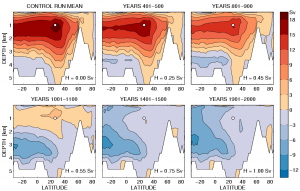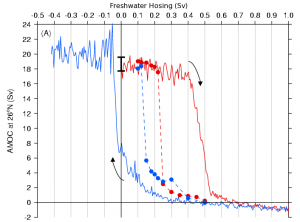UPDATE (16/06/11) – the paper describing this work has now been published and highlighted.
The potential for a rapid collapse in the strength of the Atlantic overturning circulation (AMOC) has long been recognised. The pioneering work of Stommel first suggested that the density driven circulation in the Atlantic Ocean has two equilibrium states, either ‘on’ or ‘off’. If the climate is altered, a transition may occur between these states which is not reversible by returning the climate to its previous regime (this irreversibility is termed ‘hysteresis‘). Such bistable behaviour has since been identified in a range of simplified climate models. However, up to now, no modern atmosphere-ocean coupled global climate model (AOGCM) has exhibited such behaviour, leading to the interpretation that the AMOC is more stable than simpler models indicate. In a submitted paper, we demonstrate, for the first time, the presence of hysteresis in the response of an AOGCM to freshwater perturbations in the Atlantic Ocean.
The AOGCM used is FAMOUS. Fig. 1 below shows how, as the amount of freshwater input into the North Atlantic is slowly increased over 2000 years, the strength of the AMOC collapses and a small reverse cell forms. Fig. 2 shows the AMOC @ 26N changes with the amount of freshwater added. The dashed lines indicate that hysteresis is present in the AMOC response to freshwater hosing.

